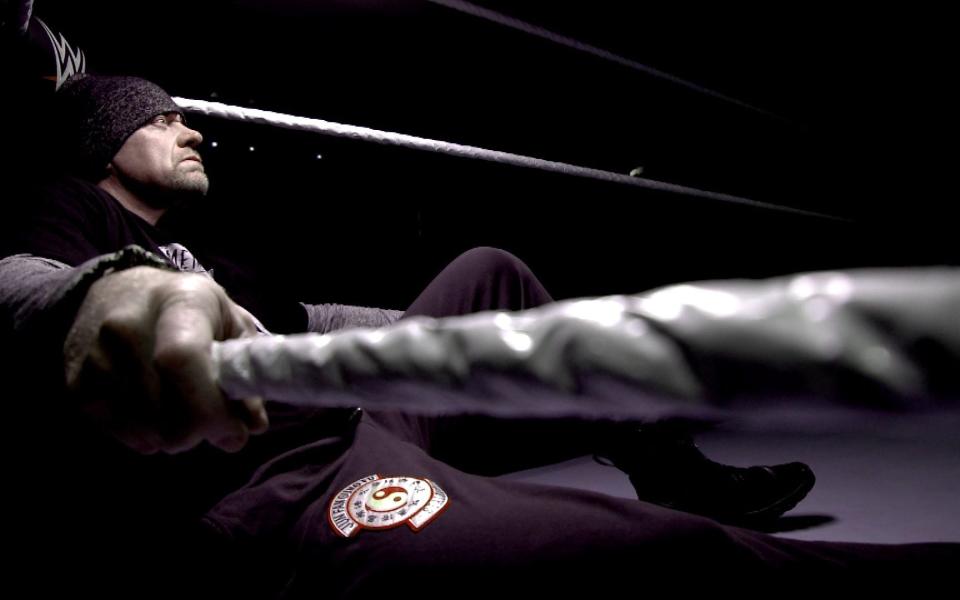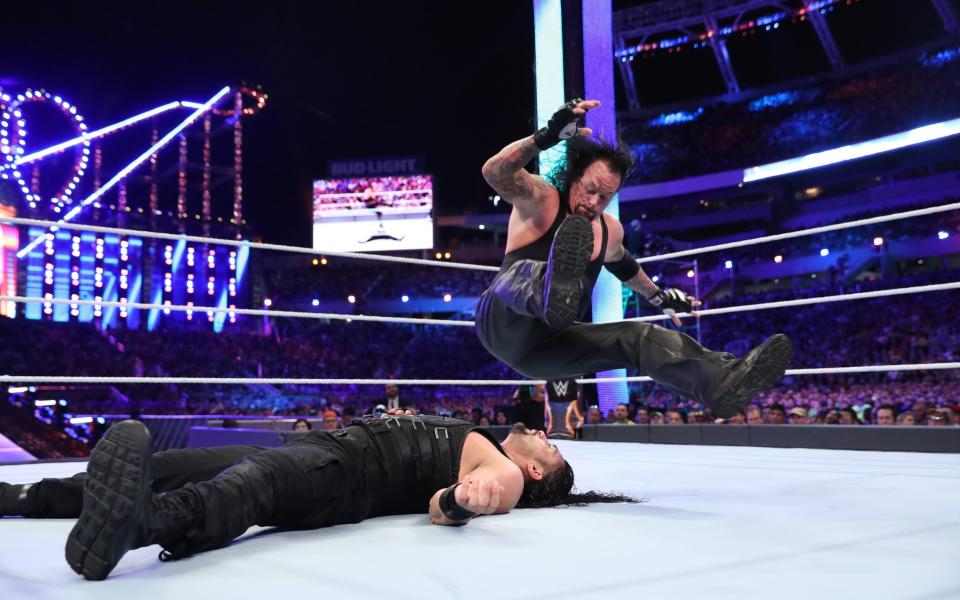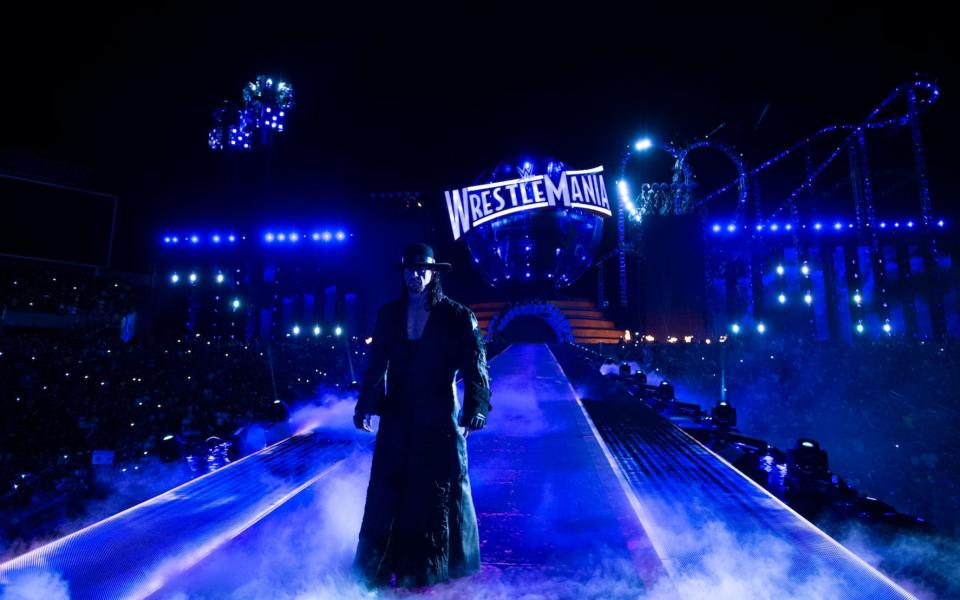The Undertaker, unmasked: the wrestling villain who hasn't broken character for 30 years

- Oops!Something went wrong.Please try again later.
Back in April 2017, I caught a real-life, just-yards-away glimpse of Mark Calaway – the man better known for 30 years as WWE wrestler The Undertaker. This rare sighting happened in Orlando, Florida, at a WWE training facility, where he was lifting weights and limbering up. By this point, The Undertaker was already in his fifties; his body had taken ample bashing.
He was preparing for what most wrestling fans believed would be his last match (it wasn’t) in the main event of WrestleMania, a super-sized show that attracts 70,000-plus each year – pre-Covid, at least – amidst a week-long celebration of wrestling. The scale and atmosphere is dizzying; somewhere between the World Cup final and San Diego Comic-Con.
Indeed, this is not rinky-dink, lower-league grappling. For WWE (World Wrestling Entertainment) – a highly glossed, corporate titan – its performers aren't wrestlers, they’re ‘superstars’; WWE isn’t even wrestling, it’s ‘sports-entertainment’.
No superstar has better encapsulated the concept of sports-entertainment than The Undertaker: a 6’9”, 309lb, highly-athletic zombie (the character has the distinction of being both a mortician and a corpse – hence his nickname, ‘The Deadman’), whose skin prickling stadium entrances are like funeral marches on a Hollywood blockbuster budget. (I’ve been in a stadium of 70,000 to witness it several times – I can attest to the skin prickling-ness).
The Deadman is also prone to supernatural antics. Lightning bolts, sudden blackouts, and an Exorcist-style levitating ring have all been part of his spooky repertoire. But for most of his 30 years, he played it for real.
The Undertaker was tightly guarded, rarely appeared out of character, and always dressed the part – even in his civvies (“You go to my house back then, open up my closet,” he once said. “I dare you to find something that wasn’t black”). His dark magic was hokey but the reputation really was supernatural.
Yet, on that day in Orlando, I was just feet away from the elusive living (dead) legend, separated by only a pane of glass. As I peered in, a heavyset security guard shooed me away; inside, a crew of WWE workers rushed over with a screen to hide The Undertaker from view.
Reporting at the time for a sports magazine, I wrote, “I can’t tell if they’re trying to maintain the mystique of the character, or just hiding the fact that after 27 years of being banged around, he looks utterly knackered.”
It was, I later realised, neither. At that very moment, The Undertaker was the subject of his own documentary series, The Last Ride. The five-part series – which is released on DVD and Blu-ray tomorrow – follows Undertaker, or Mark Calaway, over a period of three years, reflecting on his life and wrestling career, and searching – unsuccessfully, for the most part, and with painfully diminishing returns – for a final, perfect match on which to hang his own legend.
In 2020, at the age of 55, The Undertaker has finally retired. At tonight’s WWE Survivor Series event on the WWE Network – 30 years to the day since the Deadman debuted in WWE – he makes his final farewell.

The screen is finally down, and Calaway talks to me via Zoom. The Last Ride, he tells me, was his own idea; but he still questions the decision to break character. “There were several reasons behind it,” he says. “It’s crazy, now I think about it. Sometimes I have reservations. Even today, I think, ‘Why did I do that?’ I still have that internal instinct to protect that character, even though I’ve let people see behind it and see my family. It’s like I’m going to have some miraculous physical comeback. I have these arguments with myself – ‘You can’t come back now… now everybody knows you’re just like everybody else!’”
Though billed from Death Valley (where else?), the real Mark Calaway is from Houston, Texas. He was a fan of wrestling as a child, and has spoken about being “mesmerised” by once shaking the hand of 7ft-plus wrestling legend Andre the Giant. “Even as an adult you can’t describe how big Andre’s hand was,” he once said. (Big words – and I do mean big – coming from a man who’s pushing 7 ft himself.) Calaway dropped out of a college, which he attended on a basketball scholarship, to pursue wrestling – a decision he later said disappointed his father.
He wrestled his first match in 1987. After being told by rival promotion WCW “No one will ever pay to see you wrestle” he joined the colourful, kiddie-friendly WWE in 1990. Led by Hulk Hogan, the WWE roster was packed with hyper-muscled cartoon characters. Even Undertaker – who later became the most theatrical of all the sports-entertainers – says his impression of WWE before he joined was “that’s crazy… that’s crap.”
His first introduction to the character came when WWE boss Vince McMahon phoned and asked, “Is this the Undertaker?” “Yes,” replied Calaway, without knowing what that meant (other than it being a paying job). “This is the Undertaker.”

He made a surprise debut at the 1990 Survivor Series event. In other hands, the character – originally styled like an undertaker from the Old West – could have been just another ridiculous footnote in wrestling’s pantomime past. “It resonated with me right away,” says Calaway about the character. “It was different from what everybody else was doing.”
Led by his ringside manager ‘Paul Bearer’ – who carried an urn, the mysterious source of Undertaker’s power – he arrived to the sounds of a tolling bell and organ music. He moved slowly, like the living dead, and seemed impervious to pain. On the rare occasion Undertaker was knocked on his back, he would sit bolt upright, as if rising from the grave, and rolled his eyes back into his head as he choked his victims.
His finishing maneuver, the ‘Tombstone’ – a legitimately dangerous move in the wrong hands – dropped opponents on their heads, after which he'd pin their shoulders for the three count. But the 6’9” Deadman was deceptively fast and agile. He walked cat-like along the top ropes, and had sudden bursts of head-spinning athleticism. He later talked about his frustration of having to perform slowly in those early days, though it suited the character.
He likened the original incarnation to famous movie slashers. “Michael Myers and Jason Voorhees from Friday 13th – I started thinking about how those guys were,” he said in an interview with former rival Stone Cold Steve Austin. “Those guys never moved fast at all. But they always seemed to be at the right place when it was time to cut somebody’s throat.”

Though he arrived at a time when WWE was beginning to pull back the curtain on the clandestine business of wrestling, Undertaker “lived the gimmick” (gimmick being wrestling parlance for character.) “Pretty quick in the process,” he says, “it became ‘If I’m going to make this believable, make this work, and make people think I’m this mystical undead mortician, I’m going to have to live this thing.’ We travel all the time. We have to be in the public all the time. You see this on TV – an immovable force that walks though people, emotionless – so I can’t be over here walking through the airport in a Hawaiian shirt.”
Which is likely what it would have been in the early Nineties. “At the time, wrestler fashion was not the greatest,” he laughs.
It had, so he tells me, a profound effect on the real man. “It didn’t allow me to let my guard down very often,” he says. “As it went on and I had children, it became, ‘Where am I going to go in public?!’ I’d have to find places to hang out where people were used to seeing me, where they know what the story is. I couldn’t just go anywhere and have a good time. It’s one of the sacrifices I had to make in my personal life for my professional life. It became second nature. After a while I didn’t really think about it.”
Talking on The Last Ride, former opponent Mick Foley – who The Undertaker once threw from the top of a 15ft cage – acknowledged how much the character had consumed his perception of Calaway. “We all treat that character with such reverence,” said Foley. “I don’t even call him Mark anymore. I haven’t called him Mark in 20 years. It’s safe to say I know less about him as a human being now than I did 28 years ago, and I like it that way.”
The Undertaker evolved over the years, to become faster, less cartoonish. But he’s had his share of bonkers storylines. He once faced an 8ft giant in a furry bodysuit (the Giant Gonzales – a contender for worst wrestler of all time); and he wrestled his own evil doppelganger. His brother – who Undertaker accidentally killed in a fire (or so he thought) – returned as a masked 7ft monster, hell-bent on revenge.
Undertaker also commanded a ministry of evildoers and tried to marry Stephanie McMahon, Vince’s daughter, in a satanic ritual; and he’s the only television personality I can think of who has both ascended to heaven and risen from hell on live television.
In the early Noughties he reinvented himself as a more realistic Hells Angel type – until his demonic brother (who’s now the mayor of Knox County, Tennessee) literally buried him alive, after which he reemerged as The Deadman once again.
Beyond the wackiness, his legendary status played out at WrestleMania. He went 21 years undefeated at the big show. In storylines, a challenger would step up every year and try to end his undefeated streak. But every year he would defend it, usually defeating them with the dreaded Tombstone. ‘The streak’ became the attraction at WrestleMania, and was the most hotly-anticipated storyline of the year. “We started stringing a few WrestleManias together where it was like, ‘Hmm, we might have stolen the show…’” he says. “When you get that feeling, it becomes, ‘I want to steal the show.’”
Among his many WrestleMania victims was Dave Bautista, the wrestler-turned-actor who plays Drax in Guardians of the Galaxy. With Undertaker’s career already coming to a close, the streak became his reason to return to action. “The Deadman has risen!” WWE would scream at his annual resurrection.

The real art of professional wrestling is not about making audiences believe – it’s about making audiences, by sheer skill of character and performance, forget to not believe. No one really thought The Undertaker would lose at WrestleMania; it was about convincing fans that in the heat of the action that it was somehow possible.
When he finally was scripted to lose a match at WrestleMania – to mountainous wrestler and former UFC fighter Brock Lesnar in 2014 – it was a deeply unpopular decision (take all the fan bile about the final season of Game of Thrones and, much like wrestling’s relation to reality, turn it up to 11).
The match itself was a wreck. Undertaker quickly suffered a concussion and collapsed afterwards. He was rushed to hospital and has since admitted he has no memory of the night.
For fans, who were deeply invested in this near-7ft wrestling zombie, the moment was an emotional sucker punch. Not only was the streak broken, but the mystique too. Part of the Deadman had indeed died.
I have to ask: after all those years of protecting the character, was there a melancholy for The Undertaker himself in the aftermath of the streak ending? “Yeah, absolutely,” he says. “The streak at that point was one of the main reasons I was coming back every year. It had become such an iconic part in WrestleMania. My health was starting to be tested at that point, but it was important to be out there and be on that stage. When you come from where I come from – from where I started – to wrestling in front of 100,000 people… it becomes ingrained in you. It took a lot of the steam out of my sails.”

Undertaker continued to make yearly returns, but each new match was like a Tombstone to his legacy: he was broken down physically; suddenly older; and the quality of action plummeted. It’s an age-old story in wrestling: the veteran performer who can’t step away from the spotlight and fan adoration, always searching for that last big match – the equivalent of an actor needing one final Oscar-winning scene.
It was during this time that he began filming The Last Ride. It was, he tells me, “a way out… knowing that the end was coming.” Though the doc doesn’t entirely escape WWE’s highly-glossed version of reality, it’s an affecting journey.
“As much as I want to go out and perform, at this point, after 30 plus years I just can’t do the things that people expect me to do,” he says. “People have clamoured for that peak behind the curtain. This is a way I can give my fans a bit of what they’ve asked for – a glimpse of the man behind The Undertaker. But it also gives me a way out, so I don’t feel like I have to keep coming back. Obviously, a lot of the Last Ride is me looking for that one match that I can actually say, ‘I’m good, I can walk away.’”
As seen in the doc, there’s a quiet but dignified sombreness in his search for one last moment: the emotional turmoil of not being able to perform; the sudden rush of confidence when a match goes well, convincing himself he’s got a more in the tank; and the crushing defeat of failing in front tens of thousands. In one backstage scene, he appears to have a pre-match panic attack – despite being a veteran of more than 20 years by that point.
The Undertaker is renowned for his high pain threshold. But even wrestling fans will be shocked by the physical toll. In one scene, he prepares for (his second) hip replacement surgery, and explains that he’s had over 15 surgeries, including rebuilt eye sockets and a rotator cuff, a knee sculpt, and multiple muscle repairs. “There aren’t many days when I don’t wake up with something I’m in pain with,” he tells me.
To people outside wrestling, it’s hard to imagine why you’d put yourself through it. “It’s just the passion for what I do,” he tells me. “As the legacy and reputation grew, and my love of performing for the live audience grew, those things became normal – the doctor coming to see me in my dressing room, the surgeries. It didn’t seem crazy or drastic to me. It was just part of what I had to do to do what I love. If I had to, I would do it again. That was a small price to pay.”

More heartening are scenes of him as a family man, with his wife Michelle McCool (a fellow retired wrestler) and young daughter, and his close bonds with other wrestlers – some of whom were his greatest enemies. The Undertaker, it seems, is a soft touch.
“Most people have a perceived idea about what wrestling is,” he says. “But the more layers you peel back, the more you find the depth of these people. I think most people would be surprised by the relationships and things we put ourselves through.”
As seen in the final episode, The Undertaker finally found the moment to end his career. After the Covid-19 pandemic began, this year’s WrestleMania had to be reimagined. His planned match became a cemetery-set horror short – the ‘Boneyard Match’. He buried his opponent, AJ Styles, and rode off on his motorcycle – a perfect end.
The continued success of The Undertaker has been his evolution. His persona has taken many guises: Old West mortician, zombie, satanic overlord, biker. He has conflict about revealing his true self, but the final evolution of the Deadman seems to be as husband and father. As always with wrestling – a business famous for former champions who can’t give it up – the question is whether he’ll come back after The Last Ride.
“I protected the character so long that even now I second guess it,” he says about the doc. “There’s always this guy on my shoulder saying, ‘You might have one match left in you’… which I don’t! There really is no coming back after you’ve seen me playing with my little girl.”
Undertaker: The Last Ride is released on DVD & Blu-ray on November 23

